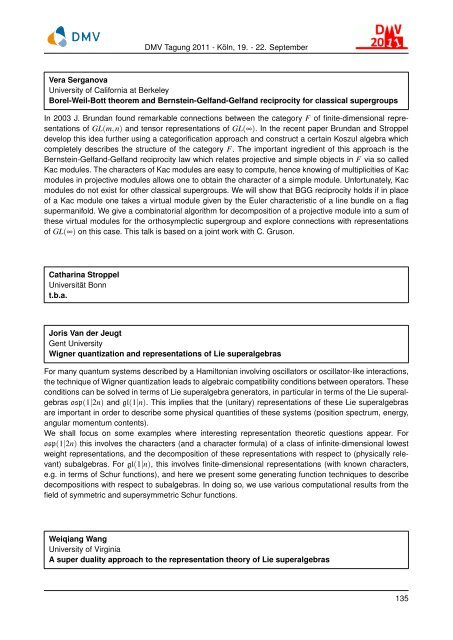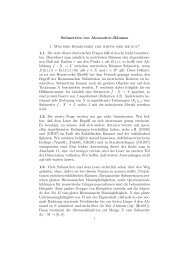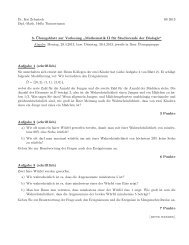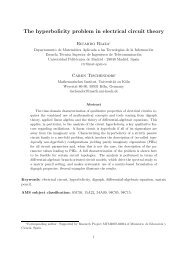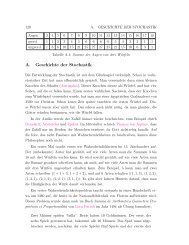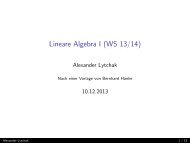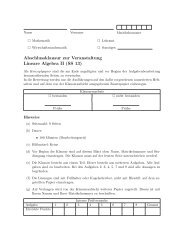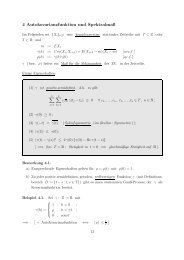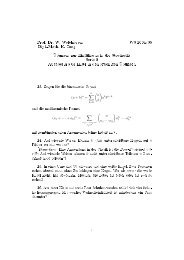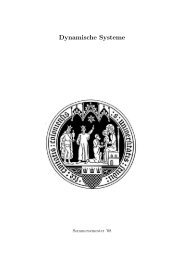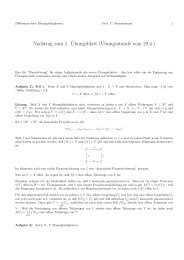Inhaltsverzeichnis - Mathematisches Institut der Universität zu Köln
Inhaltsverzeichnis - Mathematisches Institut der Universität zu Köln
Inhaltsverzeichnis - Mathematisches Institut der Universität zu Köln
Create successful ePaper yourself
Turn your PDF publications into a flip-book with our unique Google optimized e-Paper software.
DMV Tagung 2011 - <strong>Köln</strong>, 19. - 22. September<br />
Vera Serganova<br />
University of California at Berkeley<br />
Borel-Weil-Bott theorem and Bernstein-Gelfand-Gelfand reciprocity for classical supergroups<br />
In 2003 J. Brundan found remarkable connections between the category F of finite-dimensional representations<br />
of GL(m,n) and tensor representations of GL(∞). In the recent paper Brundan and Stroppel<br />
develop this idea further using a categorification approach and construct a certain Kos<strong>zu</strong>l algebra which<br />
completely describes the structure of the category F. The important ingredient of this approach is the<br />
Bernstein-Gelfand-Gelfand reciprocity law which relates projective and simple objects in F via so called<br />
Kac modules. The characters of Kac modules are easy to compute, hence knowing of multiplicities of Kac<br />
modules in projective modules allows one to obtain the character of a simple module. Unfortunately, Kac<br />
modules do not exist for other classical supergroups. We will show that BGG reciprocity holds if in place<br />
of a Kac module one takes a virtual module given by the Euler characteristic of a line bundle on a flag<br />
supermanifold. We give a combinatorial algorithm for decomposition of a projective module into a sum of<br />
these virtual modules for the orthosymplectic supergroup and explore connections with representations<br />
of GL(∞) on this case. This talk is based on a joint work with C. Gruson.<br />
Catharina Stroppel<br />
<strong>Universität</strong> Bonn<br />
t.b.a.<br />
Joris Van <strong>der</strong> Jeugt<br />
Gent University<br />
Wigner quantization and representations of Lie superalgebras<br />
For many quantum systems described by a Hamiltonian involving oscillators or oscillator-like interactions,<br />
the technique of Wigner quantization leads to algebraic compatibility conditions between operators. These<br />
conditions can be solved in terms of Lie superalgebra generators, in particular in terms of the Lie superalgebras<br />
osp(1|2n) and gl(1|n). This implies that the (unitary) representations of these Lie superalgebras<br />
are important in or<strong>der</strong> to describe some physical quantities of these systems (position spectrum, energy,<br />
angular momentum contents).<br />
We shall focus on some examples where interesting representation theoretic questions appear. For<br />
osp(1|2n) this involves the characters (and a character formula) of a class of infinite-dimensional lowest<br />
weight representations, and the decomposition of these representations with respect to (physically relevant)<br />
subalgebras. For gl(1|n), this involves finite-dimensional representations (with known characters,<br />
e.g. in terms of Schur functions), and here we present some generating function techniques to describe<br />
decompositions with respect to subalgebras. In doing so, we use various computational results from the<br />
field of symmetric and supersymmetric Schur functions.<br />
Weiqiang Wang<br />
University of Virginia<br />
A super duality approach to the representation theory of Lie superalgebras<br />
135


